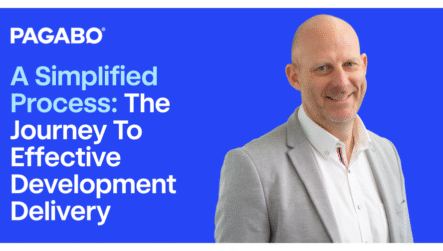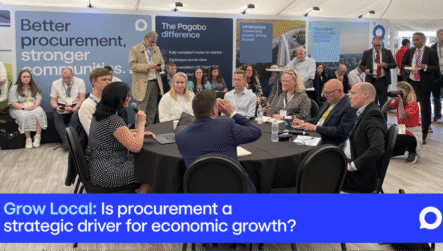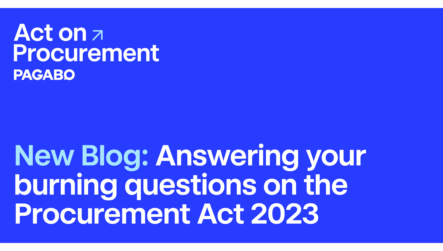Thoughts From Turner & Townsend – Navigating the New Public Procurement Regulations

“Intelligence is the ability to adapt to change.” (Stephen Hawking)
Although not quite in the same realm as astrophysics, this is still seen by Public Sector contracting authorities as a ‘big bang’ change. When the Procurement Act 2023 (the ‘Act’) came into force on the 24th February 2025; whilst it presented the sector with many challenges, these are significantly outweighed by the opportunities to review and improve previous longstanding procurement approaches, as well as now being extended throughout the procurement lifecycle from process mapping to post award contract management.
The introduction of the Act has sought to simplify routes to market insofar as to how contracting authorities engage with the market; to that end, there are now two competitive tendering processes available to be utilised under the Act:
- Open Procedure
- Competitive Flexible Procedure (CFP)
Open Procedure: familiarity but with a twist
Before we get into exploring the new CFP, it would be remiss of us to not mention the Open Procedure. Contracting authorities will have familiarity of this approach as it is similar to what was within the previous regulations. To that end, very little has changed in relation to this approach through the Act in that it remains a single-stage procedure.
It is worth highlighting that it does now incorporate the other amendments that have been implemented alongside the Act such as changes to timescales, award criteria approach (most advantageous tender), notice requirements, and mandatory/discretionary exclusion grounds.
The Competitive Flexible Procedure: a new procedure to The Act
A major notable change with the launch of the Act saw the introduction of the CFP. As a new approach for contracting authorities which essentially, replaces the four procedures that were within the previous regulations; these were: the restricted procedure, competitive procedure with negotiation, competitive dialogue and innovation partnership.
The main aim of the CFP approach is to streamline public sector contracting authorities with the ability to be more creative in terms of their procurement undertakings, this is discussed in more detail below. It is, however, worth noting that the Act is a biproduct of Brexit and as such it is UK centric, seeking to maximise upon suppliers and their skillsets, tapping into their knowledge and capabilities to drive innovative procurement outcomes.
What is it and why is it different?
As indicated above, the ‘idea’ behind the introduction of this procedure is to create greater flexibility by recognising that there are many instances where contracting authorities have specific requirements in relation to their procurement needs. As a result, the CFP permits the ability to tailor the adopted procurement approach to not only fit their unique needs but also align with the providers within that respective market.
The CFP is significantly different from the Open Procedure, due to its “design your own” nature and replaces several regulatory procedures (as described previously) into a single, more versatile approach.
When adopting the CFP approach the content within the tender notice is very important as it needs to detail not only the procedure that will be carried out but also how to access the tender documentation. It will therefore come as no surprise that alongside the publication of the tender notice that the release of tender documentation will need to be done almost simultaneously. It is worth noting at this point that despite this approach providing enhanced flexibility this does not deviate from the core principles of public sector procurement, those being: transparency, efficiency and compliance.
When seeking to procure via a CFP; there are two polar opposite procedures linked to the market conditions, those being simple and complex. The Act also provides the possibility for contracting authorities to adopt a hybrid approach in addition to those outlined within this article.
The simple procedure is condensed into a two-stage process:
- The assessment of tenders with the identification of shortlisted suppliers
- The assessment of demonstrations
This process involves fewer steps and stages, creating an allowance for the procedure to be streamlined, more efficient and is optimal for lower risk, straightforward procurement such as typical everyday commodities and services. Utilising a CFP in this instance would still permit the opportunity for the inclusion of conditions of participation and in effect, this approach could mirror a simple restricted procedure.
A complex procedure will involve multiple steps and stages. The Act permits contracting authorities to design this multi-stage CFP if the requirement of the public contract is more intricate (and in many instances perhaps, bespoke). As for stages, this complex procedure allows opportunities to include stages for negotiation, dialogue, further down selection, BAFO (best and final offer) and presentations amongst others.
Prior to issue of procurement documentation, preliminary market engagement will be an essential step at the beginning of a process to help captivate interest and understand the market capabilities. Moreover, considerations for the subject matter to be procured is essential, especially when considering which procedure to undertake. Utilising preliminary market engagement as a feature will enhance the chances of adding value to the procedure in addition to reducing risk and to help to ensure the right outcomes are achieved.
A noteworthy advantage that this procedure provides is the ability to harnesses the attributes of flexibility to a greater extent, creating detailed and beneficial interactions with suppliers.
It is important to be mindful of proportionality when adopting this procedure. This is highlighted within the section 20 of the Act which informs that the principle of proportionality in public procurement, seeks to ensure that the procedures used are appropriate and balanced, considering the specific characteristics of the contract.
This reiterates that it is fundamental to consider whether the approach that has been designed is proportionate to what is being procured as you do not want to have a procedure that is overly burdensome.
Adopting CFP
In order to appropriately utilise CFP, contracting authorities will need to review and develop their existing policies and procedures along with any other and procurement ‘template documents’ they use.
From an organisational wide perspective, adopting this procedure will involve significant stakeholder communication such as seeking expert procurement support and legal advice prior to obtaining the necessary governance approval. It is essential for internal discussions to focus on how the CFP will be implemented to ensure the alignment of wider policy documents.
As previously alluded; any approach that is designed will need to be advertised clearly and concisely, detailing the number of stages, whether there will be a reduction in the number of suppliers during the process and if there will be some form of negotiation included, as part of the published tender documents.
Opportunities and Benefits
While incorporating new approaches can be challenging, there are several opportunities and benefits comprised within the CFP.
It is a given that a complex CFP will be best utilised when there is a requirement for major construction projects given the ability to design a process to extract the innovation across the market whilst not compromising best value or in fact the desired outcome.
CFP actively encourages increased engagement with the market (and the suppliers within) furthermore, it also incorporates the elements of research and development, design and build and the inclusion of prototypes where possible.
Opportunities within this procedure are vast. Tailored and customised processes to fit the market can reduce barriers, simplify processes with the introduction of new suppliers (including SME’s) which amplifies the existing competition. Also, to align with the changing of procurement project requirements, contracting authorities can refine award criteria at distinct stages of the process.
Whilst some of the benefits and opportunities highlighted are greatly welcomed by the public sector, care must be taken to avoid any ‘black holes’ particularly during this formative period of the post ‘go-live’ era. As a result, it is essential that contracting authorities are suitably upskilled in relation to the variety of resources, guidance and training that is available to fully embrace and maximise these opportunities.
Conclusion
Considering the above, companies that supply to the public sector are recognising that it is vital that they too are informed and educated as to the Act and what it mandates. Having a greater understanding of the CFP will help to ensure that they are able to maximise their potential and showcase capabilities when not only bidding for opportunities but also delivering contracted goods, works and services in the event of them being successful.
This thought piece was produced by Flavia Forbes and Chris Robinson of Turner & Townsend who are on The Professional Services Framework which we manage on behalf of contracting authority The Education Alliance Trust .
For more information on The Professional Services Framework, click here.
Discover our frameworks



































